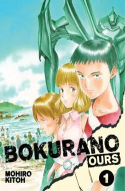 From the back cover:
From the back cover:
Having cheated death, Hikari Hamura must save himself by using his artistic abilities to help others.
Hikari Hamura, nicknamed Picasso because of his natural artistic abilities, survived a horrible accident, but his friend Chiaki wasn’t so lucky. Suddenly, Chiaki appears in front of him and tells him in order to keep living he must help the people around him. Can Hikari save people with his sketchbook and a 2B pencil?
Review:
Moody and misanthropic Hikari Hamura doesn’t want to have anything to do with his classmates. He’d much rather practice drawing in the style of his favorite artist, Da Vinci, and dream of becoming an important artistic figure. His only friend is a girl named Chiaki, but one day, while she’s reading nearby as he’s sketching a river, they are both killed in a freak helicopter crash.
Chiaki is the only one who stays dead, however. At the moment of her death, she prayed that someone would intercede and save Hikari’s life. Her request was granted, on the condition that Hikari use his artistic skills to help people. This she explains to him when he pulls her miniature winged form out of his front pocket and starts freaking out in the middle of class.
Hikari isn’t interested in this arrangement until she points out that he’s going to start rotting away unless he complies. Over the course of the volume, Chiaki and an increasingly less reluctant Hikari help out four fellow students. Somehow, Hikari is able to see the state of their “heart” and draw a symbolism-heavy picture, which he and Chiaki can then enter and attempt to decipher what’s going on. There are aspects of this premise that I like a lot. For example, why does Chiaki suggest Hikari attempt to draw her heart before the helicopter crash? What was it that she slipped into his pocket? Is she really there at all? Is Hikari just crazy?
Frankly, I hope that’s the case, because most of these scenarios are pretty simplistic and silly (not to mention repetitive). The worst is probably the case of Akane, a classmate who is perpetually weak because of a vegetable allergy. By drawing her heart, Hikari realizes she has a childhood trauma stemming from the death of a pet rabbit and, while inside the drawing, gives Akane’s baby self a big hug while reassuring her that “vegetables aren’t scary.”
Furuya’s art is definitely one of the more impressive aspects of the manga, as he completely switches his style when drawing as Hikari and maintains that style when the characters are sucked into Hikari’s drawings. Even though the heart drawings are full of fairly ridiculous symbolism they’re quite detailed and obviously took some time to create.
In the end, Genkaku Picasso is not quite as good as I thought it would be. Still, it’s only three volumes long and I’m curious enough to see it through to the end. I hope that what I’m reading as hints about Chiaki really are meant to be so, which might mean more interesting material lies ahead.
Genkaku Picasso is published in English by VIZ. Volume one is available now and volume two is scheduled for a February 2011 release. The series is complete in three volumes.
Review copy provided by the publisher.








 Fifteen kids—most of them, except for one boy’s kid sister, in 7th grade—are taking part in a summer program called “Seaside Friendship and Nature School.” Chafing at the instruction to go out and observe nature, the kids decide to explore a nearby cave, where they inexplicably discover a computer lab and a strange guy who calls himself Kokopelli.
Fifteen kids—most of them, except for one boy’s kid sister, in 7th grade—are taking part in a summer program called “Seaside Friendship and Nature School.” Chafing at the instruction to go out and observe nature, the kids decide to explore a nearby cave, where they inexplicably discover a computer lab and a strange guy who calls himself Kokopelli. Bokurano is structured similarly, focusing on each pilot as he or she “gets the call.” There are merits and flaws to this approach: obviously, the current pilot receives a lot of attention, and it’s interesting to see how each approaches the responsibility differently. One boy cares nothing for human casualties while another carefully takes the battle out into the harbor to minimize damage. One girl uses her final hours to sew morale-boosting uniforms for the group. Unfortunately, this also means that at any given time there are about a dozen characters relegated to the background, waiting for their turn to contribute to the story.
Bokurano is structured similarly, focusing on each pilot as he or she “gets the call.” There are merits and flaws to this approach: obviously, the current pilot receives a lot of attention, and it’s interesting to see how each approaches the responsibility differently. One boy cares nothing for human casualties while another carefully takes the battle out into the harbor to minimize damage. One girl uses her final hours to sew morale-boosting uniforms for the group. Unfortunately, this also means that at any given time there are about a dozen characters relegated to the background, waiting for their turn to contribute to the story.









Recent Comments